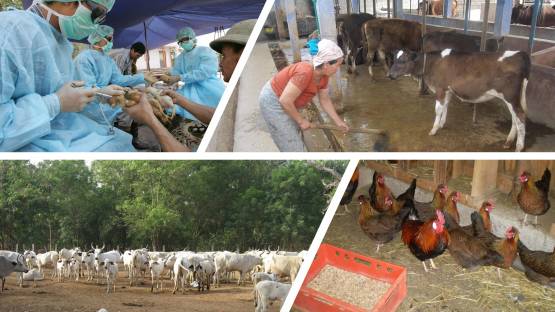The IAEA is calling on research organizations to join its new five-year Coordinated Research Project (CRP) on innovative nuclear and related molecular approaches for detection and characterization of antimicrobial resistance (AMR) in animal production environment. Causing over a million deaths annually, AMR is a global health concern, dubbed as a ‘silent pandemic’.
Antimicrobial drugs are used in farm animals for therapeutic, prophylactic and growth promotion purposes. Emergence of AMR in animal production systems and its transmission to humans is a major issue, considering the fact that more than two-thirds of antibiotics sold globally are used on animals.
National AMR surveillance programmes have mostly focused on the detection of AMR in human health and in animals for food safety purposes, but little attention has been given to animal production facilities. Active surveillance of AMR in animal production settings is constrained by lack of guidelines, harmonized sampling protocols and cost-effective technologies for detection and characterization of AMR. Most analytical methods are focussed on detection of AMR/ARGs (antimicrobial resistance genes) in selectively cultured bacteria, but many microbial species are non-culturable/difficult to grow.
Stable isotope and molecular/genomic techniques offer powerful culture-independent approaches to detect potential antimicrobial resistance in farm animal environment samples. Antimicrobial agents have long been used at sub-therapeutic levels in livestock feed as growth promoters to improve production efficiency. Although such antibiotic growth promoters (AGPs) have provided benefits to livestock industry, their use contribute to the emergence of resistance among microbes in the gut environment. Hence, identifying effective alternatives to AGPs will be an important approach to reduce antimicrobial usage in animal production settings.
This new IAEA project will target three major animal production systems, namely pig, chicken and cattle. The CRP will help develop validated/harmonized protocols for sampling and analysis of farm environment samples, distribution characteristics of drug resistance among infectious agents affecting livestock, scientific data on performance of candidate alternative substances to AGPs in animal production and strategies/guidelines on optimal husbandry practices that improve biosecurity and mitigate AMR in animal farm premises.
The CRP will comprise 8 Research Contract holders from developing countries, three Technical Contract holders and three Research Agreement holders from laboratories engaged in advanced AMR research. Each selected research contract holder will be awarded a seed grant of USD 10,000/year for a period of five years. Nuclear techniques involving isotopes such as 60Cobalt (develop irradiated para probiotics as AGPs), Deuterium (novel AMR phenotyping in difficult to grow bacteria), 13Carbon and 15Nitrogen (stable isotope labelled amino acid approaches for antibiotic sensitivity testing) and molecular/genomic techniques (such as polymerase chain reaction, sequencing, and next generation sequencing) will be utilized to achieve the objectives.
CRP Objectives
The overall objective is to enable Member States, especially developing countries, to use innovative nuclear and related approaches for enhancing the efficiency and effectiveness of national AMR surveillance programmes and promoting good husbandry practices to mitigate AMR in animal production settings.
The CRP’s specific research objectives are to
- Develop, evaluate and validate farm-level sampling methods (e.g., bioaerosol, water, feed, feces) for detection of AMR in high- and low-input animal production environments,
- Establish AMR distribution characteristics in high- and low-input animal production environments using nuclear, molecular and microbiological techniques,
- Assess the efficacy of alternatives to AGPs as feed additives in animal production settings,
- Establish scientific evidence on development and transmission of AMR at animal–human–environment interface.
- Evaluate and optimize phenotyping and genotyping methodologies related to drug resistance in animal infections other than bacteria (e.g., anthelmintic resistance, acaricide resistance, antifungal resistance)
- Pilot and recommend good husbandry practices or antimicrobial stewardship that aim to reduce the risk of emergence and occurrence of AMR in farm animal settings.
How to join the CRP
Research organizations interested in joining the CRP must submit their Proposal for Research Contract or Agreement by email, no later than 9 April 2023, to the IAEA’s Research Contracts Administration Section, using the appropriate template on the CRA website. Same template can be used for both research contract and technical contract. The IAEA encourages institutes to involve, to the extent possible, female researchers and young researchers in their proposals. For further information related to this CRP, potential applicants should use the contact form under the CRP page.




